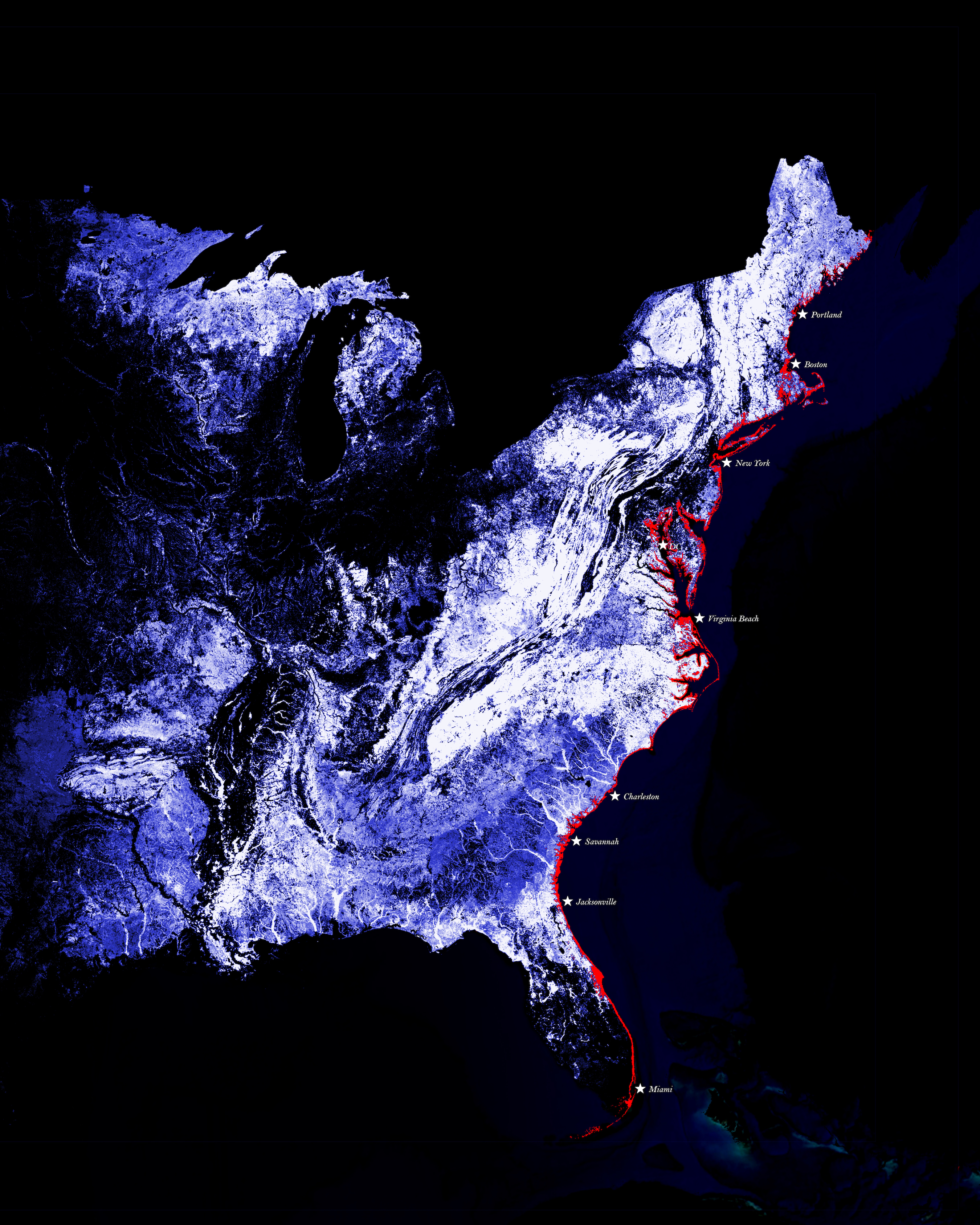This Is What America Could Look Like When Our Coasts Are Under Water
Credit to Author: Shayla Love| Date: Tue, 23 Jul 2019 13:29:07 +0000
Soldier’s Grove is a small town of fewer than 600 people located near the Kickapoo River in Wisconsin. The Kickapoo is not a genial body of water. In 1907, the river flooded, dumping record amounts of water into downtown Soldier’s Grove. Then it did so again in 1912, 1917, 1935, 1951, and 1978. The town saw 25 nationally declared flood disasters in a 38-year period.
“Each time there was very little advance warning,” the county sheriff said in a Federal Emergency Management Agency (FEMA) report. “People woke up at night with three to four inches of water already in their homes.”
In 1937, the residents of Soldier’s Grove decided they’d had enough and petitioned Congress to help them fund a solution. It took 32 years, but in 1975, the town got a proposal for a $3.5 million levee to protect their $1 million worth of property. After considering the math, the citizens of Soldier’s Grove came up with a different plan for the money: They would move the town to higher land.
By 1983, the relocation was complete. And Soldier’s Grove hadn’t just rebuilt, it had made improvements. The business district became the country’s first “solar village,” in which all commercial buildings had to get at least half of their energy from the sun, a radical gesture for 1983. The medical center, the pharmacy, the library, the fire station, the post office, and more, all ran on solar—and still do.
Soldier’s Grove is an early example of managed retreat: a proactive, intentional shift of civilization away from an environmental threat. Today, managed retreat is a potential strategy for survival in the face of rising sea levels from our rapidly changing climate. While most major cities talk only about walls and infrastructure to protect against the encroaching sea, Soldiers Grove is a model of how retreat can be a cost-effective option, and a chance to do something more than just run away.
The question isn’t whether we will retreat, it’s how we will retreat.
In the past 30 years, 1.3 million people have vacated their homes through managed retreat. Most of the time, individual houses are bought out by government agencies, like FEMA, in areas hit by repeated climate disasters. But sea levels are continuing to rise, and could even be accelerating, according to a recent NASA study. By 2100, 72 to 187 million more people could be displaced, forcing us to rethink our piecemeal strategies.
Those working in climate science, sociology, urban planning, and law are grappling with how managed retreat can be more than an option of last resort. Scientists and policy makers envision that if carefully planned, retreat could be a tool to reckon with social and racial inequalities, and the reality that global warming will exacerbate these injustices.
Depending on how we do it, we face very different coastal futures. In one scenario, our coastlines will be dotted with derelict ruins—the haunting remains of communities that weren’t given a chance to get out of harm’s way. Cities will exist behind walls built that protect from the ocean, and there will be no access to the shoreline.
In a more egalitarian vision, U.S. shores could be reclaimed as public land. A national shoreline could serve as a natural buffer to the ocean, and if paired with affordable housing, community investment, and employment, moving away from the coasts could promise survival but also, better quality of life.
“The question isn’t whether we will retreat, it’s how we will retreat,” said A.R. Siders, an environmental fellow at the Harvard University Center for the Environment. “In that, we have a lot of choice and a lot of opportunity.”

The word “managed” is crucial to the concept of true managed retreat. Retreat alone is what happens when coastal areas are hit too hard by a disaster and become unlivable. More than a decade after Hurricane Katrina, New Orleans still has tens of thousands of abandoned homes. “They didn’t want to live there and they moved away,” Siders said. “Well, that’s retreat. It doesn’t have any management. There’s no support system. There’s no assistance. People go on their own.”
The best and simple version of managed retreat is when local and federal governments step in to help and provide resources to people who can’t move on their own, and want to go.
Moving people ahead of any actual disaster might sound extreme, but in fact, a serious conversation about retreat is happening decades too late, according to Susanne Moser, a researcher on climate adaptation affiliated with Stanford University and the University of California-Santa Cruz. Soon, it won’t just be clusters of houses that need to be bought. Overnight, half of a city—say Charleston, South Carolina—might have to move. We currently have no national framework to deal with this.
“What’s so mind-boggling is that half of the U.S. population, and more than half of GDP, come out of coastal counties, and we don’t have an idea of how we’re addressing accelerating sea level rise, against which we cannot protect forever,” Moser said.
But in March of this year in New York City, $500 million was dedicated, not to retreat and relocation, but to a wall to protect from rising water. New York is among other coastal American cities pledging to build infrastructure to shield themselves.
Even if a wall works for a specific area, it shifts erosion and flooding to either side of the wall, Siders said. If New York City erects a wall around itself, it doesn’t stop flooding, it just pushes it somewhere else. “And we can’t put a wall around the entire United States,” she said. “So everywhere we build a wall and choose to protect one place, we’re putting another place at risk.”
Moser agreed, saying it’s also wildly expensive, aesthetically garish, ecologically damaging, and probably won’t work everywhere. In Florida, the water can come also from below, so “you’d end up filling in that nicely protected bathtub you’ve created,” she said.
Building walls also summons images of a dystopian future. “You could end up with these walled city-states and then everyone else is just left to fend for themselves,” said Liz Koslov, an assistant professor at the UCLA Department of Urban Planning and Institute of the Environment and Sustainability. “These protected cities would be seen as too big to fail and increasingly become the provinces of the wealthy.”
We already know that the people who suffer the most, and most immediately, from environmental harm are working class people and people of color, said Daniel Aldana Cohen a sociologist at the University of Pennsylvania.
You could end up with these walled city-states and then everyone else is just left to fend for themselves.
“At this point in the United States, in this moment of climate emergency, unless we take action, we are pushing towards a world of eco-apartheid,” Cohen said. “It’s strengthening already-existing forms of exclusion and inequality and violence.” To have managed retreat create a better future, Cohen said, we need to plan outside of the scope of the government buyout.
Though FEMA, one federal agency that facilitates housing buyouts, has spent more than $2 billion on threatened houses from 1993 to 2011, we know very little about how these decisions affect people or communities—the exact demographics of whom was bought out, and where they went.

Essentially, FEMA makes decisions based on what is cost-effective, meaning it tends to buy less-valuable homes. Siders worries that that strategy is creating inequitable situations that we aren’t keeping track of, or know how to fix.
For example, if mostly cheaper homes are being bought, that means buyouts could be disproportionately offered to lower-income and minority residents and the waves of ecological migration will be made up of only marginalized people, a trend already being seen in places like Central America.
The conversation on retreat has been much too focused on the question of leaving and not enough on the question of arriving.
At the same time, poorer communities can sometimes have less access to relief funds. In places like New Orleans or Houston, white neighborhoods recovered faster than Black ones after hurricanes. We won’t know what these conflicts are and how to resolve them until we include these considerations in all our retreat conversations, Siders said, but we should be aware that any version of managed retreat will be happening in the context of the injustices that already exist in our country.
Managed retreat also needs to deal with the fact that often, the communities most burdened by climate change are the ones that have been historically displaced or disenfranchised, Koslov said. Because of that history, trust levels in sweeping federal policies are understandably low.
During the New Deal in the 1930s, the promise for affordable housing and relocation was not made accessible to Black people. Koslov said it’s necessary to include communities in retreat conversations, and advocate for it to be restorative, so that communities feel more empowered and willing to participate.
“The decision to leave has to be made democratically as much as possible,” Cohen said. That doesn’t mean every individual homeowner is going to agree. But I think the best version of retreat is it’s democratic, that people are excited about it.”
Could people get “excited” about leaving their homes? Possibly, if there was somewhere better for them to go.
One option, Cohen said, is a kind of Green New Deal, but for places to live—referring to the push for environmental legislation and investment by politicians like Alexandria Ocasio-Cortez. Something similar for housing could ensure new places for people to work and live if they decide to retreat, and could circumvent an alternative where managed retreat ends up being monetized by big developers.

Cities that receive influxes of migrants will need investments to support their new populations. And people leaving their ancestral homes or feeling the threat of natural disasters could benefit from access to emotional support and counseling. Since many people who are not monetarily rich live very richly in their communities, Cohen said, we should think about how to move people together, not just individually.
Taken one step further, managed retreat could also find purpose for the material from the homes left behind. “We could basically have a coastal recycling industry,” Moser said. It would be an even bigger project than the interstate highway program in the 1950s, and could be a source of jobs and income for millions of people.
“It’s worth asking, are there conditions under which 10, 15, 20 million people moving would be a good thing?” Cohen said. “Could this be an improvement on life? To me, the conversation on retreat has been much too focused on the question of leaving and not enough on the question of arriving. Once you do that, then moving becomes an opportunity to live better in a new place.”
Soldier’s Grove had something that proposals for walls don’t: Imagination. In 2007, the Kickapoo River had its biggest flood ever. The water easily surpassed the levees and didn’t recede for 10 days. Luckily, the people in the town had already left for safer ground.
We need more of this creativity, especially when it comes to buyouts, Siders said. She thinks that a lot of policy hesitation comes from a belief that retreat is the same as giving up. We consider it “resilient” when we build back in the same place, and nostalgia makes us want things “the way they were.”
Managed retreat is a complex, multi-faceted, expensive prospect, but those who study it still think it contains an opportunity to make our societal and living structures better than before. It reminds Siders of a quote she likes from combat veteran Oliver Prince Smith. While commanding a division during the Korean War during a retreat, he proclaimed: “Retreat, hell! We’re not retreating, we’re just advancing in a different direction.”

We need to be transformative, and not resilient, Sider said. “If the best that we can come up with is to rebuild a home in the same place in the same way, that is an utter lack and failure of imagination.”
But the longer we wait, the fewer choices we have. “We’ve basically used up all the luxury time that we had, and now it’s crunch time,” Moser said. “I mean, we probably have three people in FEMA working on this right now, for the entire country. That’s not going to be how this is going to work.”
Siders and Rosetta Elkin, a landscape architect at Harvard Graduate School of Design, have one transformative suggestion: A national seashore. They propose turning the entire U.S. coast into a public park, so that everyone could still walk along the beach with no private-property restrictions. It would create a natural buffer from the water as well as preserving access to the coast for more people.
“The idea of the seashore is that we do something great and create a new shore where people could still enjoy,” she said. “If we don’t retreat, if we start building up seawalls and that’s our solution, then you don’t have beaches and you lose public access. If we want to be the country of giant walls and no beaches, that’s our path. But I don’t think that’s the path of most people want.”
Follow Shayla Love on Twitter.
Sign up for our newsletter to get the best of VICE delivered to your inbox daily.
This article originally appeared on VICE US.